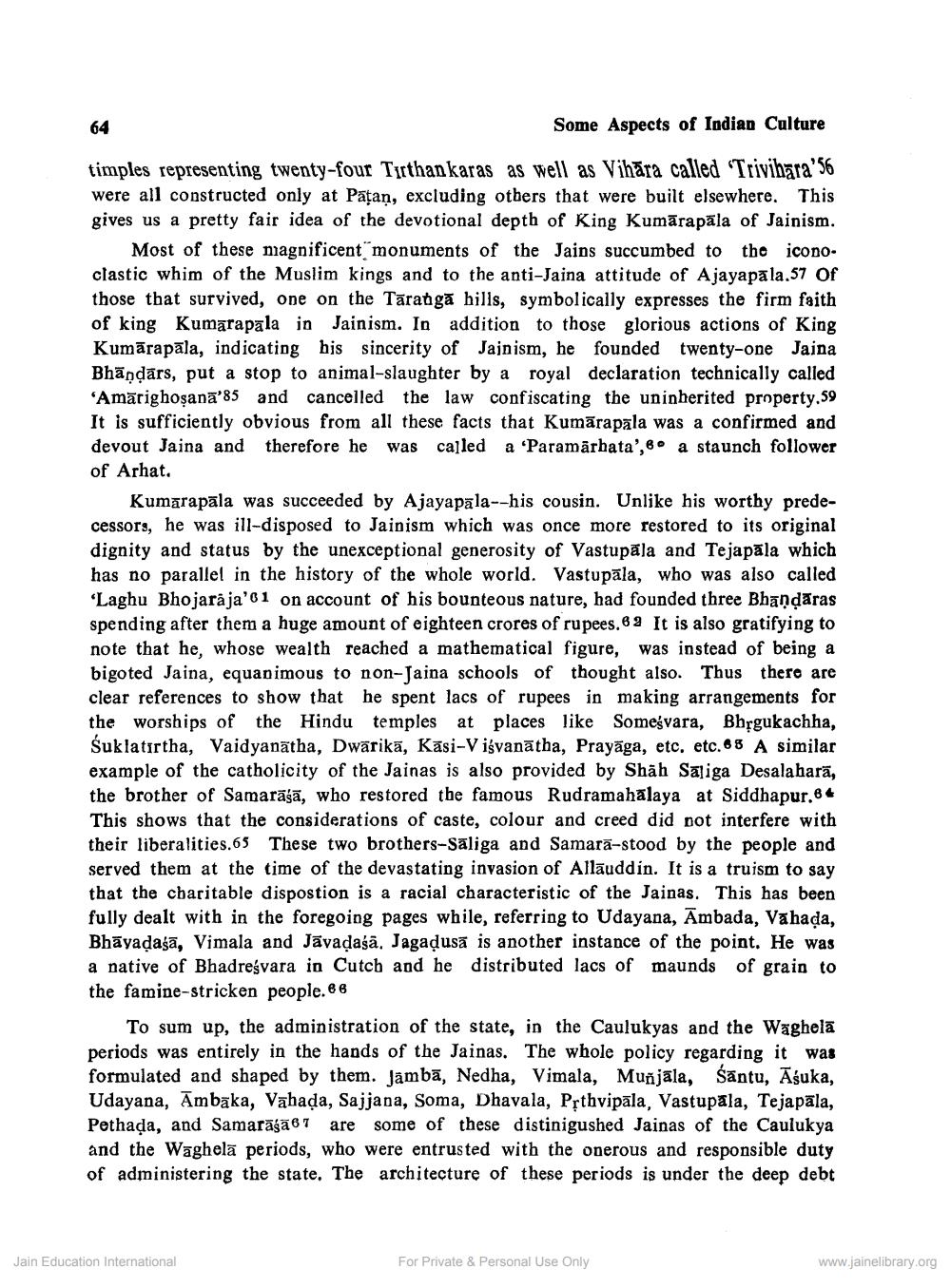________________
64
Some Aspects of Indian Culture
timples representing twenty-four Tirthankaras as well as Vihara called Trivihara 36 were all constructed only at Patan, excluding others that were built elsewhere. This gives us a pretty fair idea of the devotional depth of King Kumārapāla of Jainism.
Most of these magnificent monuments of the Jains succumbed to the iconoclastic whim of the Muslim kings and to the anti-Jaina attitude of Ajayapala.57 Of those that survived, one on the Tārangā bills, symbolically expresses the firm faith of king Kumarapala in Jainism. In addition to those glorious actions of King Kumārapāla, indicating his sincerity of Jainism, he founded twenty-one Jaina Bhāndārs, put a stop to animal-slaughter by a royal declaration technically called 'Amārighoşanā'85 and cancelled the law confiscating the uninherited property.59 It is sufficiently obvious from all these facts that Kumārapala was a confirmed and devout Jaina and therefore he was called a 'Paramārbata', & a staunch follower of Arhat.
Kumarapāla was succeeded by Ajayapala--his cousin. Unlike his worthy predecessors, he was ill-disposed to Jainism which was once more restored to its original dignity and status by the unexceptional generosity of Vastupala and Tejapāla which has no parallel in the history of the whole world. Vastupāla, who was also called ‘Laghu Bhojaraja'61 on account of his bounteous nature, had founded three Bhandaras spending after them a huge amount of eighteen crores of rupees.82 It is also gratifying to note that he, whose wealth reached a mathematical figure, was instead of being a bigoted Jaina, equanimous to non-Jaina schools of thought also. Thus there are clear references to show that he spent lacs of rupees in making arrangements for the worships of the Hindu temples at places like Somesvara, Bhțgukachha, Suklatirtha, Vaidyanātha, Dwārikā, Kāsi-Visvanātha, Prayāga, etc, etc.68 A similar example of the catholicity of the Jainas is also provided by Shāh Sajiga Desalaharā, the brother of Samarāsā, who restored the famous Rudramahalaya at Siddhapur.8 This shows that the considerations of caste, colour and creed did not interfere with their liberalities.65 These two brothers-Saliga and Samarā-stood by the people and served them at the time of the devastating invasion of Allāuddin. It is a truism to say that the charitable dispostion is a racial characteristic of the Jainas. This has been fully dealt with in the foregoing pages while, referring to Udayana, Ambada, Vahada, Bhāyadašā, Vimala and Jāvadašā. Jagadusā is another instance of the point. He was a native of Bhadreśvara in Cutch and he distributed lacs of maunds of grain to the famine-stricken people.&6
To sum up, the administration of the state, in the Caulukyas and the Waghela periods was entirely in the hands of the Jainas. The whole policy regarding it was formulated and shaped by them. Jämbā, Nedha, Vimala, Muñjala, śāntu, Āśuka, Udayana, Ambāka, Vahada, Sajjana, Soma, Dhavala, Pșthvipāla, Vastupala, Tejapāla, Pethada, and Samarāžā67 are some of these distinigushed Jainas of the Caulukya and the Waghelā periods, who were entrusted with the onerous and responsible duty of administering the state. The architecture of these periods is under the deep debt
Jain Education International
For Private & Personal Use Only
www.jainelibrary.org




